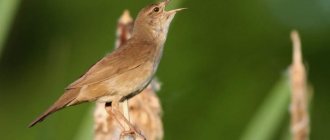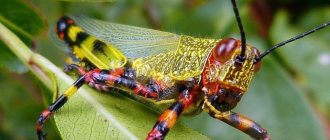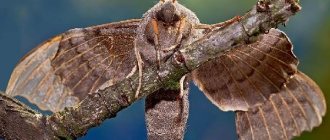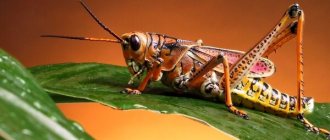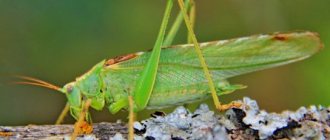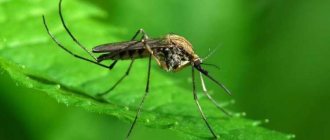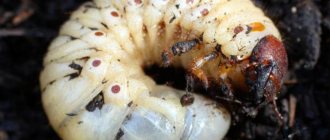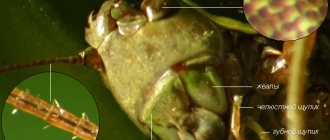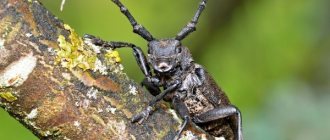- Wild animals
- >>
- Insects
A curious little insect, which, on the one hand, can be unpleasant to the human eye, but on the other hand, delight our ears with its melodic sound. When we walk in a park or forest clearing in warm and dry summer weather, we hear hundreds of unusual “bugs” making sounds with different timbres and frequency, proudly called crickets .
History of appearance and types of crickets
These insects appeared on the planet approximately 300 million years ago. They belong to the Orthoptera order and the True crickets family, which includes 8 subfamilies. Zoologists currently describe 2,300 different discovered species. Approximately 50 species of crickets live in Russia. Of these, the most popular are brownie and field.
Interesting Facts
- Since ancient times, crickets have been especially revered in China and Japan, in these countries they even organized special competitions for singing domestic crickets, and the rich people there were ready to give entire fortunes for the winners.
- Since ancient times, it was believed that having a cricket in the house brings good luck, prosperity, and well-being.
- According to recent research by scientists, the trills of crickets have a beneficial, calming effect on the human psyche. Only the purring of a pet has a similar positive effect on a person.
cats.
Habitat area
Crickets are indigenous to the Far East and North Africa. But then they spread throughout Europe. Somewhat later they appeared in North America and South Australia. The field cricket prefers steppe and forest-steppe zones and mountainous European regions. In the center of Russia it is most often found in the north of the country, on the border of its range.
In the Tula region, field cricket can be found mainly in the southern stripe, in the Vanevsky, Kimovsky, Efremovsky, Odoevsky, Kurkinsky and Novomoskovsky districts.
Field cricket: habitat and places of settlement
Crickets are heat-loving insects. They live in places where the temperature reaches at least 20 degrees. At lower temperatures, insects become inactive and almost completely stop feeding. In villages, crickets love places near stoves in winter and go to live in nature in summer. They prefer warmth, light and sun. They willingly settle in meadows and fields.
In the mountains, crickets usually choose to live on gradual, dry slopes where limestone is exposed or settle in adjacent heaths and meadows. But where they warm up well. Nowadays, crickets are more “modernized” and prefer to live not behind stoves, but on livestock farms. It is not only warm for them there, but also a lot of food. Or they settle in warm basements, boiler rooms and heating mains.
True grasshoppers (family)
It is best to begin our acquaintance with the world of these creatures with the members of this family. And not only because its name is “real”. It’s just that it is also the most numerous of all, including two dozen subfamilies. Its representatives are often quite large.
Most of them prefer plant foods and are even considered pests of tree species and agricultural crops. But among them there are also predators, as well as varieties with mixed nutrition. Let's take a closer look at some of them.
Song grasshopper
Such creatures have little ability to fly, although their wings are developed and, when folded, reach the end of the abdomen, but are protected by short elytra. But, as the name suggests, representatives of the species are simply excellent “singers”. They give their concerts in the crowns of trees and tall bushes.
And their chirping can be heard far around the area, and therefore in calm weather it can be heard several hundred meters away. The size of grasshoppers is significant and is about 3 cm. In addition, the females have a clearly visible ovipositor, the length of which is almost comparable to their own.
The main part of the body of insects is colored green. They are found in Europe, including Russia, excluding the cold regions north of Moscow, and to the east their range extends to Primorye. Specimens of the warbler variety are often seen in mid-summer and autumn. They feed on leaves of shrubs, sedges, cereals, and insects.
Grasshopper Shelkovnikova
Also refers to the species of grasshoppers , in Russia . Such insects are found mainly in the European part, in its southern regions. The Shelkovnikova variety is larger than the previous one just described.
In addition, it differs from the “warblers” in the structure of the front legs, one of the segments of which is expanded heart-shaped. Otherwise, both species are very similar, and therefore they are often confused when found among the grass and low bushes, where green jumpers usually hide.
Gray grasshopper
This variety is also called variegated because its representatives have different colors. It can be not only gray, marked with brown spots, but also green, as well as reddish or olive. The body length of such grasshoppers is approximately 3 cm, with the largest being females, growing to sizes of 4 cm or more.
A similar species is found in Europe, most often catching the eye of a person in the grass on the plains and mountain slopes. Such grasshoppers belong to the category of predators. And their singing is heard only during the day.
Their Latin species name translates as “wart-absorbing.” And there are reasons for this. It is believed that the brown liquid secreted by these insects (actually their salivary glands) cures the painful growths mentioned.
White-fronted grasshopper
An inhabitant of southern Europe, often hiding among dense weeds on roadsides and wastelands, found in forest edges and meadows, and in gardens. Despite their large size (up to 6 cm) and the fact that such grasshoppers are found not far from a person, they rarely catch his eye, hiding in the grass.
And if the white carp realizes that it has been spotted, it quickly flees and hides in the depths of the vegetation. But during daylight hours it is often possible to hear its melodic chirping, which can even be confused with birdsong. This species is capable of flight, moving over short distances.
Such grasshoppers have a protective coloring, which further contributes to their inconspicuous existence. Their colors, if you look closely, are very interesting: a complex pattern is applied to the gray-brown main background. Such grasshoppers are called white-fronted because their heads are light in front.
Their antennae are short, which is how they differ (as well as their small size) from some types of locusts, but otherwise they are quite similar in appearance. These creatures are capable of harming fruit trees and cultivated cereals, but also feed on insects and consume other types of protein foods.
Ashy bushweed
Among the members of the family there are also rare species of grasshoppers . These include the ashen bush, which is also found in the Moscow region. She lives in meadows among tall grasses and in the lower branches of bushes, in forest clearings and edges. But its settlement sites are local, and therefore measures are being taken to protect the species.
This insect is also found in other areas of central Russia, where the voice of such grasshoppers can be heard until late autumn. Representatives of the species are completely unsuited to flight. These are small grasshoppers, not exceeding 2 cm in size. Their color, according to their name, is ashen.
Rezel jump
The variety is named after the entomologist Rezel. Its representatives are small in size and brown-green in color. A characteristic external feature is three stripes on the head: two dark and one light. As a rule, such grasshoppers do not fly, having short wings, but there are exceptions.
In European territories, this variety is quite widespread and is found as far as the south of Siberia; it was also artificially introduced and took root on the American continent. Such insects are useful because they eat aphids and other pests, but also feed on herbs.
Green grasshopper
The size of such insects, often found in meadows and pastures, on the outskirts of forests, among woody vegetation and grasses of the coastal strip, is about 3 cm. These are predators, and such that, on occasion, they are capable of resorting to cannibalism; they also eat butterflies and other insects. But in difficult times, they consume plant foods: flowers, buds, grass and leaves of shrubs, as well as cultivated crops, and therefore belong to the category of pests, although not malicious.
Females can be distinguished from males by their sickle-shaped ovipositor, which is characteristic of all true grasshoppers. Other features of the appearance are: a head flattened from the sides; long mustache; the right elytra covered by the left. Grasshoppers for the most part have a protective coloration. As already noted, these creatures are shy and do not like to be seen.
It often happens that, looking directly at this insect, among the branches and grass, it is almost impossible to distinguish it. And only by making the jump does it reveal its presence. The colors of such creatures correspond to their environment. And therefore it is not surprising that we have already encountered species of green grasshoppers .
This variety also has this characteristic, as the name itself suggests. Such grasshoppers are also called ordinary, which indicates how typical they are. They are found almost throughout the entire territory of Eurasia, as well as in Africa, and are known as record holders for jumps, the length of which is about 3 m.
Steppe dybka
Dybki form an entire genus in the family of true grasshoppers, which itself is divided into 15 species. Most of them are found in Turkey, the rest live in various regions of Eurasia, as well as on the American continent. A striking representative of the genus, although an endangered species, is the steppe rack, which still catches the eye of people in the Volga region, the Caucasus, the Crimea and some countries of South-Eastern Europe.
This is a large grasshopper. For example, female representatives of the species can sometimes grow up to 8 cm, not counting the size of the ovipositor, which itself can be up to 4 cm long. Such insects have a very elongated body. Their head is sloping down and back at an acute angle. The wings are underdeveloped or completely absent.
There are a lot of thorns on the sides below. The legs, despite their considerable size, are thin and not adapted for significant jumps. The color of such creatures is green, greenish-gray, sometimes with yellowish tint. A characteristic stripe runs along the body. The habitat of such grasshoppers is virgin feather grass or wormwood steppes, sometimes rocky areas overgrown with low bushes.
leaf grasshopper
It has already been noted that grasshopper insects tend to adapt their colors to the surrounding landscapes. But among them there are those who have been very successful in this, merging with nature in the most amazing way.
A striking example of this is the leaf grasshopper, the appearance of which is a real living green and juicy leaf that even copies the veins of the plant. And the paws of the wondrous creature turned into twigs. The homeland of such grasshoppers is the Malay Archipelago, where they successfully exist among tropical vegetation.
Spiny Devil
The entire body of such grasshoppers is covered with sharp large needles-thorns, which became the reason for the name of the variety. Such an extravagant costume becomes for these creatures real and reliable protection from many enemies, in particular birds of prey and some species of monkeys that live in the equatorial forests of South America, mostly near the Amazon River.
This is where our grasshoppers are found, and their greenish-emerald coloring also serves as a good camouflage for them.
Appearance
The field cricket is quite small in size. Body length is from 17 to 23 centimeters. Males are larger than females. Crickets have a large head and a dense body. They are mostly black in color, but there are also brown ones. They have short front wings. Field crickets, unlike other species of their counterparts, are larger. The color is darker, the thighs are red below and inside.
Females have a thin ovipositor at the back, widened at the tip. And the shins are reddish in color. Males are distinguished by the presence of a mirror on the elytra. The sound apparatus is similar to that of a grasshopper. But in crickets it is more complex.
These insects have long antennae and three pairs of legs. The entire body (abdomen, chest and head) is covered with a durable chitinous cuticle. The jaws (mandibles) of crickets are quite powerful. All senses are well developed - touch, smell and vision. Thanks to their antennae, crickets are great at smelling and tasting food.
Field cricket: lifestyle features
He is the only insect that builds a nest for himself, in which he lives throughout his short adult life. Crickets are solitary creatures by nature. Each individual has its own territory. If she belongs to a male, then he can allow several females to live nearby.
Crickets live in nature in burrows up to 20 centimeters deep and 2 cm wide. They never go far from their home. At the slightest danger, the cricket hides in a hole. The entrance to it is masked by a tuft of grass. Crickets are very careful and timid, as they have a lot of enemies - small mammals, birds and lizards.
CHIRRING
The characteristic chirping of a cricket is the sound created as a result of friction between the right wing of special veins located on the left wing. The chirping is clearly audible, since the raised wings are the sound resonator. Seven wing friction cycles per second create 4,200 vibrations that sound four octaves above middle C. Male field crickets chirp from May to July, sitting at the entrance to the burrow. With the help of this “singing” they attract the attention of females and at the same time keep competitors at a respectful distance. In cold rainy weather, crickets are silent, but on sunny days they chirp all day long.
Reproduction
During the breeding season, males sit near their burrows and call females with songs. Raising his front wings, the gentleman rubs them. Due to this, a kind of love serenade in the form of chirping is obtained. The female may not come. If the date does take place, then she will soon lay approximately 30 eggs in the ground. Over the entire breeding period, a total of up to 500.
During mating, the field cricket suspends a spermatophore similar to the one found in grasshoppers from the abdomen of the chosen one. But crickets do not have spermatophylax. When the female begins to lay eggs, she sticks her ovipositor vertically into the ground. Then he closes the hole, moves to the next place, and the procedure is repeated.
The larvae appear between two and four weeks. And in appearance they already look like adults in miniature. There is no pupation stage in crickets. The larvae always stay together. During growth they molt three times. And then they begin to separate. Each cricket begins to dig its own hole and prepare for the winter.
After winter, the young field cricket comes to the surface in the spring, when the temperature reaches +4 degrees. The last time the molt occurs, and after it the insects become adults. Then a new breeding season begins.
Content
There are people who keep crickets at home in insectariums (special kindergartens). They are mainly made of plastic. One garden can accommodate hundreds of crickets. It is important to provide sufficient food and water, as well as maintain a comfortable temperature for these insects. It is necessary to include protein foods in the diet. Crickets happily eat dry food for aquarium fish - gammarus or daphnia. If insects do not have enough protein food, they will begin to eat their weaker brothers.
Nutrition
They are not picky when it comes to food. It is enough for them in the summer. All plant foods are used, from grass to plant roots. In winter, in secluded home dwellings, they also do not remain hungry.
Even if they go on a hunger strike, crickets do not disdain laying eggs of similar insects or dead relatives, which once again emphasizes their penchant for cannibalism.
Crickets, specially bred as an ornamental house insect, eat whatever is given to them - fruits, vegetables, food for other animals, bread crumbs, baby food and table scraps.
Insects need protein food, which is found in fishmeal and egg whites. Overeating insects is strictly contraindicated. This causes their chitin coating to deteriorate and causes problems with molting.
It is better to grate all vegetables and fruits. A prerequisite for crickets is the presence of water. It is not necessary to pour it into the drinking bowl, just moisten the sponge well with it.
How to get rid of crickets
How to destroy a field cricket living at home? There are several ways to do this:
- You can use a natural trap. Condensed milk is poured into a small container. Mixed with water and placed near the place where the cricket lives. An insect attracted by the smell jumps into the prepared syrup.
- Chemical trap. It is used indoors if there are no pets or small children in the house.
- Adhesive strips. They are placed near windows, on doors and walls. Insects stick to them.
- Spray. You can use any insect repellent, even Dichlorvos. But such sprays should be sprayed if there are no children or pets at home.
- Some people use a regular vacuum cleaner to kill crickets. You need to change or remove the nozzle and go through all corners of the house. In this way, even unborn offspring can be destroyed.
Ecology is important for the reproduction of crickets. The field cricket feeds not only on plant foods, but also eats smaller fellows. And even insect corpses, since crickets need protein. But thanks to their insatiable appetite, they can cause considerable harm in summer cottages. Crickets eat any plant and its roots. Therefore, sometimes dacha owners have to get rid of the invasion of “singers”. You can do this in several ways:
- the use of complex measures - chemical and agrotechnical;
- Regular loosening of the soil helps a lot;
- the area can be treated with biological products “Antonem-F” or “Nemabakt”;
- install birdhouses or bird feeders on the site;
- Snakes help very well in the fight (these are the enemies of crickets);
- after harvesting in the fall, you need to clean the area, clearing it of wood, chips and film residues to prevent crickets from overwintering under them;
- You can use box baits;
- wormwood can simply be laid out between the beds or watered with a decoction prepared from this herb;
- You can sprinkle the ground near the stems with hot hot pepper.
Cricket fights “without rules”
The aggressiveness of male crickets has given rise to an unusual gambling spectacle - fights. There is a version that they were invented in China approximately 1000 years ago, during the reign of Sun. But cricket fights were also held with no less success in Thailand and Malaysia.
For this purpose, insects were caught at the end of summer. Then the male crickets were released into a mini-arena. They immediately began to fight until the bitter end. The defeated person was thrown out of the arena, fled from it, or was killed by his opponent. The winner was even given a certain title.
Such cricket fights were very expensive, the stakes were very high. The remains of the winners were then stored in silver mini-coffins. During their lifetime, fighting crickets were looked after by specially hired people. The insects were on a specially designed diet, and for colds they were even given medications. To raise the tone and morale of the crickets, females were brought in for 2 hours every day.
Fighting insects were kept in special semi-precious houses or in pumpkins or bamboo hollowed out from the inside. Sometimes the cages were made of ivory or turtle shells. The most beautiful houses were found only in the imperial palaces.
Peculiarities
The field cricket is an endangered species. Noted as a rare and localized species. In the Tula region, only 9 habitats of field crickets have been observed. This is a rare species. Crickets are not at all prone to dispersal, but if their numbers increase, especially in hot summers, then insects can fly away and settle even hundreds of meters from their usual habitats. Since they dig holes for themselves, they avoid settling on arable land or in excavation sites.
The life cycle of crickets is from 90 to 120 days. But an adult insect lives only a month and a half. There are also “long-livers” who live for 7 months, but they live in the tropics. Field crickets, including wintering, last from 14 to 15 months.
The field cricket sings using its elytra, which it rubs against each other. They are tough and the process produces a beautiful warble. Crickets can sing all day long, often in the evenings and even at night. But at the slightest danger or alarm, they calm down and hide in their holes.
Video
And in conclusion, we invite you to listen to the sound of a cricket in the video yourself.
Author: Pavel Chaika, editor-in-chief of Poznavaika magazine
When writing the article, I tried to make it as interesting, useful and high-quality as possible. I would be grateful for any feedback and constructive criticism in the form of comments on the article. You can also write your wish/question/suggestion to my email [email protected] or Facebook, with respect, the author.
Author page
